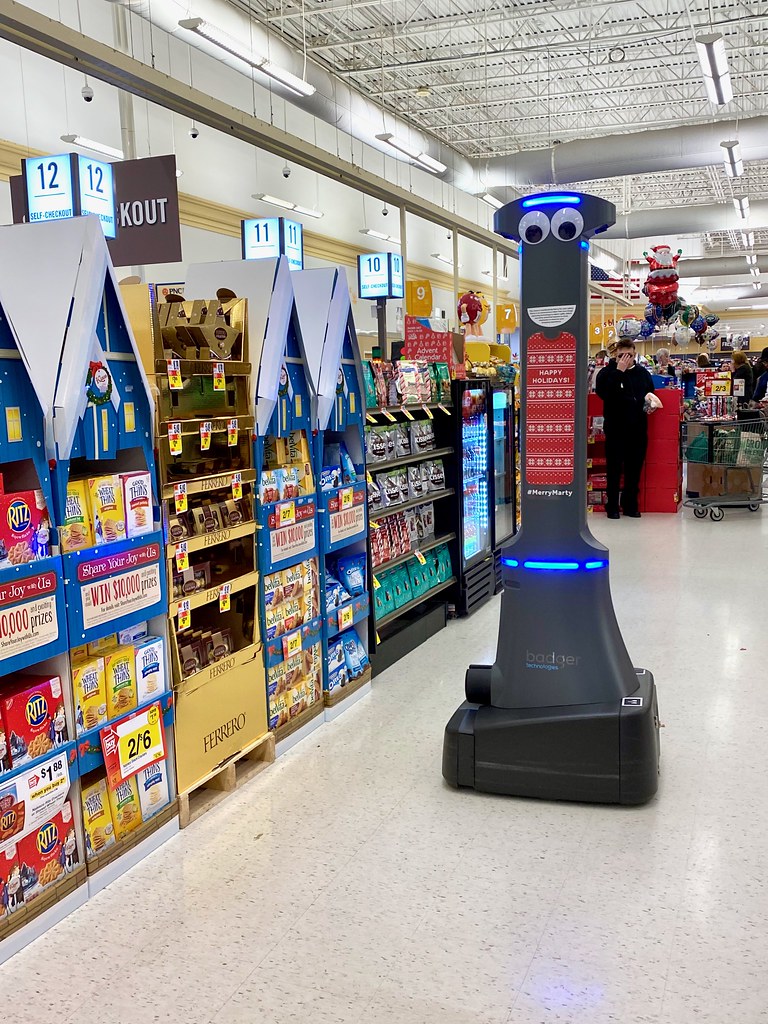Introduction
On the latest episode of the Enterprise Mobility Roundup Podcast, BlueFletch’s Brett Cooper and Tim Kane of Zebra Technologies sat down to discuss retail trends and predictions in 2024.
Ahead of the 2024 NRF conference, BlueFletch wanted to break down some of the main topics of discussion. This blog highlights a recap of 2024 trends and a few upcoming trends retailers should be aware of moving into the new year.

2024 Retail in Retrospect
Shifting Customer Expectations
Emerging from the ripple effects of the COVID-19 Pandemic, many aspects of the industry shifted towards finding technologies to support new consumer expectations, including:
- Online Ordering
- Contactless Pickup
- Home Delivery from the store
- Improved Safety Protocols
Many companies dealt with these new challenges by changing operational processes and updating technology to support these shifts. 2024 was a year of innovation in the retail technology landscape as retailers attempted to adapt and keep up with these shifts in consumer expectations.
Retail Labor Challenges
On the labor and employee side, retailers were forced to address challenges around:
- Hiring and retention of employee
- Dealing with reduced staff availability
- Retooling employee processes to support new ordering and delivery capabilities.
Finding, training, and retaining labor was one of the most significant challenges of 2024. The pandemic left many organizations needing a consistent and trainable workforce as turnover rates rose. Layoffs in specific segments during the year’s second half did little to increase the pool of available employees. 2024 saw a consistent gap across the industry between organizational needs and employee productivity.
Additionally, frequent turnover rates plagued retailers as money was spent training employees who’d leave soon after. In some cases, new hires did not make it beyond the first shift. This new environment forced retailers to evaluate how old business practices were hurting their organizations in the new retail climate.
In response to these labor challenges, many retailers began aggressively deploying company-owned mobile devices. These devices brought a new level of accessibility in the field for end-users to perform their daily tasks better. These devices also saw a proliferation. When outfitted with the appropriate applications, these devices streamline the work experience for warehouse and front-end employees alike.
Economic Softening
In 2024, retailers faced significant challenges due to economic softening. As consumers’ disposable incomes decreased and unemployment rates rose, spending on non-essential items dropped. This led to declining sales and revenue for many retailers. Additionally, the shift to online shopping accelerated during the economic downturn, further impacting brick-and-mortar stores. Many retailers were forced to close stores and reduce staff as a result. The shift to online shopping has also increased competition, making it difficult for retailers to attract customers and drive sales.
Supply Chain Challenges
The pandemic’s supply chain disruption led to delays in manufacturing and transportation, resulting in widespread shortages of popular and essential goods. The increased demand for certain products, such as personal protective equipment (PPE) and home office equipment, put additional strain on the supply chain. As more people stayed home, a lot of shopping moved online.
This led to stockouts and higher prices for many retailers, resulting in lost sales and customer dissatisfaction. Furthermore, the supply chain disruptions made it difficult to plan and forecast inventory. Many retailers scrambled to find new suppliers and navigate changing logistics and tariffs, adding to the uncertainty.

New Trends in Retail Mobile Technology
As we move into the new year, there are a few emerging trends in mobile technology in the retail space.
- Increasing functionality available to users
- Optimizing and improving end-user experience
- AI supporting end users
- Communication tools
Increased Mobile Functionality Available to Users
With the rise of trends such as BOPIS (buy online, pick up in-store) and contact-free shopping, many customers have changed how they shop. These trends that began during the pandemic have become the new normal, and businesses have learned how to adapt using Shared Devices.
Shared Android devices and applications can help retail employees do their jobs by providing them with tools and information that allow them to better serve customers, process transactions, and manage store operations.
How Mobile Devices Improve the Retail Experience
- Applications: Creating and using applications specific to the needs of a unique work environment is a helpful way to streamline employee productivity. Retailers can build applications in-house or outsource third-party developers to curate applications that integrate perfectly into their environment.
- Point of Sale (POS) systems: allow employees to process transactions quickly and accurately and provide access to customer information and purchase history.
- Inventory management: Applications can help employees track and manage store inventory, making it easier to restock items and track sales trends.
- Customer relationship management (CRM): These tools allow employees to access and update customer information and help them provide personalized service and support. Organizations should be cautious as regulations around data collection are constantly changing. Be vigilant about where data is stored and how it is used.
- Communication and collaboration: Shared Android devices and applications can help employees stay connected and with management, enabling them to share information and work together more effectively.
- Tracking Analytics: Certain MDMs and Identity providers allow retailers to track, download, and access device use analytics such as login data, activity, and location. These are valuable tools when gauging how devices are used in the field and how devices can better assist end-users. However, organizations must be cautious of local, state, and federal privacy laws. In the EU, GDPR is strictly enforced and protects users against certain malpractices. Organizations must move carefully when using sensitive data.
Overall, shared Android devices and applications help retail employees work more efficiently and effectively, ultimately improving the customer experience and contributing to the business’s success.
Optimizing and Improving the Mobile Experience for Retail Associates
Mobile technology innovations drive how retailers improve the employee and customer experience. Here are a few areas retailers need to be focusing on:
- Refining the User Interface (UI) & User Experience (UX): At the core of the mobile device landscape is an appealing UI & UX, particularly one that engages and welcomes end-users. In a world of endless customization, associates want to feel comfortable with the devices they use at work. A barrier can form between a user and their device experience when the UI is not accessible, appealing, or helpful. Working with skilled designers to curate a quality UX for your end-users is crucial to finding success with shared workforce devices.
- Implementing Voice Technology: Communication is the foundation upon which a successful retail business is built. When employees can speak across the workplace, there’s a greater sense of teamwork and belonging. Integrating voice technology like phone calls and push-to-talk mobile features is essential to bringing together a team.
- Device Training: Nearly everyone owns a personal mobile device outside of work. This is a significant benefit of using mobile devices in the workplace, as employees are likely to adopt the technology quicker as they’re already familiar with the basics of mobility. Take advantage of this by using devices as a conduit for training. Using a standard learning tool can be an effective way of training new hires.
AI Supporting the End User
The increasing use of artificial intelligence (AI) and machine learning (AI) has helped personalize the shopping experience for customers alongside the rise of E-Commerce. AI plays a significant role in how retailers refine how they reach their customers through targeted ads and curated social media campaigns.
AI and ML open the floodgates of actionable data, allowing retailers to understand their customers’ wants and needs better. Additionally, ML technology on company-owned devices has ushered in new forms of authentication using biometrics. Advancements such as facial recognition have helped strengthen shared mobile security by offering secure authentication alternatives.
Alongside AI is the growing popularity of virtual and augmented reality technology and the emergence of new payment technologies like cryptocurrency and mobile payments. There has been a trend towards using data analytics and real-time tracking to better understand customer behavior and preferences, as well as robotics and automation in the retail industry.
Increase In Communication Tools
Single sign-on (SSO) is a technology that allows users to access multiple applications and services with a single set of credentials. This can be beneficial for retailers in several ways. First, it can improve security by eliminating the need for employees to remember multiple passwords and reducing the risk of password-related security breaches.
Second, it can increase productivity by allowing employees to quickly and easily access the applications and services they need without having to log in to each one individually. Third, it can improve the user experience by providing a seamless and convenient way for employees to access the tools they need to do their job. Additionally, SSO can help to reduce IT support costs by simplifying the process of managing user accounts and passwords.
It is difficult to estimate precisely how much retailers can save per employee by implementing SSO technology, as this will depend on several factors, such as the number of applications and services that the employee uses, the number of employees at the company, and the type of SSO solution that is implemented.
However, by reducing the time employees spend logging in to multiple applications and services, SSO can help increase productivity and efficiency. This can lead to time savings and cost savings for retailers. Additionally, by reducing the risk of password-related security breaches, SSO can help to reduce the costs associated with security incidents. Ultimately, the potential cost savings of implementing SSO will depend on the specific needs and circumstances of the retailer.
2024 Retail Trends to Watch
Increase In Communication Tools
- Personalizing the Shopping Experience: Retailers are using AI to personalize recommendations and offers based on a customer’s past purchases and browsing history and improve the accuracy of inventory management and forecasting. Mobile commerce is also becoming increasingly popular as more consumers use their smartphones to shop online and make purchases.
- Virtual (VR) and Augmented Reality (AR): AR is beneficial for things like virtual try-on experiences for clothing and accessories. This technology can change how people shop by allowing them to try on and visualize products from their homes. However, AR and VR tech is still in its infancy, and it is not yet understood if their potential use cases will be a concrete pillar in the future of retail.
- Mobile Payment: Apple Pay, Google Pay, Venmo, PayPal, and other payment technologies are gaining popularity as contactless payment has become the preferred amount for certain businesses. These technologies offer a more convenient and secure way to make purchases and are likely to become more widely adopted in the coming years.
- Analytics: Finally, data analytics and real-time tracking are helping retailers to understand customer behavior and preferences better and make more informed decisions about how to market and sell their products.
- Robots: In various locations around the NorthEast, supermarket chain Stop N Shop launched a robot named Marty. Marty was designed to clean up spills and monitor the store. While it’s an exciting experiment, the use of robots in retail is still sparse. Robots such as Marty need to augment the store experience in such a way that justifies their cost.
Retail Beyond the Horizon
The Future of Brick and Mortar Stores
Oberlo found the United States had about 226.7 million online shoppers in 2024. This number is projected to rise above 291 million by 2025. With more shoppers moving online, the future of the brick-and-mortar store has come into question.
These are vital statistics to consider when evaluating the success of the traditional storefront in 2024. E-Commerce, mobile payment, and virtual shopping have become easier ways to shop for many people. However, despite the increased popularity of online shopping, retailers have continued to adapt the in-person experience to meet consumer needs better.
To better serve their consumers, Target remodeled over 1,000 stores in 2024. These renovations improved the efficiency of same-day shopping services like BOPIS, drive-up, and contactless services like self-checkout and mobile payment-compatible POS terminals. Remodeled Target locations have dedicated spaces for storing and prepping mobile orders. They’re now better equipped to support these services and provide customers with more shopping options.
As the design of physical stores is changing, so is the variety of use cases. As mentioned above, same-day shopping services like BOPIS have become a standard, not just a trend. This also allows stores to be turned into micro-distribution centers for faster shipping. Delivery is costly, and the pandemic showed the industry’s vulnerability when shipping is threatened. The shipping and delivery process could become more efficient by making stores micro fulfillment facilities.
We expect the design and daily operation of physical stores to continue to change into 2024.
Where should Retailers be Investing in the Future
With so much ground to cover across this ever-evolving retail landscape, budgeting for 2024 may seem daunting. Here are a few key areas we suggest investing in:
- Mobile Devices: Invest in making devices more robust, accessible, and effective.
- Analytics: Leverage data to better tune retail services and workplace systems. AI and ML are two incredible tools that retailers should feed actionable data into for improving business practices.
- Mid Market: Be an innovator and early adopter of technology. Leverage the incredible tools, applications, devices, and systems to better your business. Retailers do not want to be on the lagging end of technology, waiting for others to improve before evolving themselves. Companies should always look ahead to see how emerging or existing technology can further benefit their workplace.
- Inventory: Be weary of inflation and excessive inventory. Invest in tools to manage warehouses and stockrooms better to avoid an overabundance of inventory.
The Next 5-10 Years
What's next?
It is difficult to predict with certainty what technology trends will emerge in the retail industry over the next 5-10 years, as this will depend on several factors, including technological advancements, changes in consumer behavior and preferences, and the evolution of the retail landscape.
However, some of the trends that are likely to continue to gain momentum in the coming years include the increasing use of artificial intelligence and machine learning to personalize the shopping experience, the rise of mobile commerce and the use of smartphones to make purchases, the growing popularity of virtual and augmented reality technology, and the emergence of new payment technologies like cryptocurrency and mobile payments.
Additionally, there is likely to be an increasing focus on data analytics and real-time tracking to understand better customer behavior and preferences, as well as the continued use of robotics and automation in the retail industry.
Employee Engagement and Augmentation
One significant challenge on the horizon is generating a healthy relationship between employees and their workplace. The general attitude around work has shifted globally, especially in the United States. Over the last couple of years, as continuous social and global pressures have risen, more people have lost their connection to their work.
Retail is one industry that relies on passionate employees who feel a part of a community. Finding ways to bring together motivated teams of engaged individuals will be something organizations need to evaluate in 2024 and beyond. Creating a welcoming, accepting, and the engaging work atmosphere is the best way to start.
Conscientious Products and Suppliers
In 2024, retailers will likely be more strategic about selecting and sourcing inventory. Supply chain disruptions and spikes in consumer demands left an impression on the industry. Retailers will re-evaluate their sourcing strategies and supplier relationships to mitigate damage for potential future disruptions. This could mean building more resilient and diversified supply chains, emphasizing local sourcing, and shortening lead times.
Additionally, retailers may focus more on sustainability, and ethical sourcing as concerns about the environment and workers’ rights have become more prevalent. This could result in scrutiny of the products and suppliers to ensure they meet specific standards. Retailers must take a more responsible approach to mitigate risks, meet customer demands and uphold consumer expectations.
Inventory and Supply Chain Optimization
Balancing inventory is another challenge that will grow over the coming years. As commerce continues to expand to the internet, retailers must find a way to balance in-store and online inventory. Sound stock management systems and dedicated warehouse employees will be critical to keeping a real-time record of what’s in stock. Mislabeled list counts and mismanaged systems negatively affect same-day services such as BOPIS or drive-up that rely on having real-time stock information.
Conclusion
In 2024, the retail industry faced challenges due to the COVID-19 pandemic, like adapting to a contactless shopping experience and finding and retaining labor. Many retailers deployed company-owned shared mobile devices to streamline the work experience for store associates and increase productivity.
In 2024, shared Android devices, SSO, analytics, AI, and ML technologies are expected to play a significant role in the retail industry, helping retailers personalize the shopping experience for customers and improve the efficiency of store operations.
If you enjoyed this blog, check out our latest Enterprise Mobility Roundup Podcast Episode with Tim Kane from Zebra Technologies, where Brett and Tim break down emerging retail trends.


